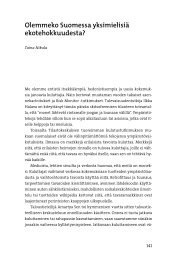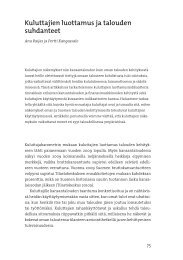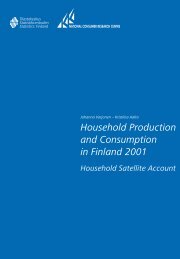Household Production and Consumption in Finland 2001
Household Production and Consumption in Finland 2001
Household Production and Consumption in Finland 2001
You also want an ePaper? Increase the reach of your titles
YUMPU automatically turns print PDFs into web optimized ePapers that Google loves.
Shopp<strong>in</strong>g, runn<strong>in</strong>g err<strong>and</strong>s <strong>and</strong> related travel account for around one-fifth<br />
of the value of production. Their share is greatest <strong>in</strong> families with children,<br />
reflect<strong>in</strong>g the nature of activities <strong>in</strong> bigger families (e.g. the need for<br />
transport<strong>in</strong>g children). The amount of time spent <strong>in</strong> these activities has<br />
<strong>in</strong>creased substantially over the past few decades.<br />
Life-stage <strong>and</strong> population structure determ<strong>in</strong>e<br />
household production<br />
The relative weight of different pr<strong>in</strong>cipal functions <strong>in</strong> household production<br />
varies at different life-stages. Results at the household level show that the age<br />
of household members seems to impact the volume of household production<br />
<strong>and</strong> particularly the share of labour <strong>in</strong> that production. The share of labour<br />
<strong>in</strong>creases with advanc<strong>in</strong>g age, both among people liv<strong>in</strong>g alone <strong>and</strong> among<br />
couples, while the share of f<strong>in</strong>al consumption purchases decreases, <strong>and</strong> so does<br />
the share if housework related travel <strong>and</strong> shopp<strong>in</strong>g.<br />
The volume of household production per household is lowest <strong>in</strong><br />
s<strong>in</strong>gle-person households under 45, where labour furthermore accounts for the<br />
smallest proportion of the value of production. In this group the hous<strong>in</strong>g<br />
accounts for over one-half of output, which is more than <strong>in</strong> other types of<br />
households. This suggests that household production has only a m<strong>in</strong>or role <strong>in</strong><br />
the life of young people, except of some production <strong>in</strong> hous<strong>in</strong>g services.<br />
<strong>Household</strong> output is highest <strong>in</strong> families with small children. In their case<br />
almost one-third of the value of production comes from the provision of care.<br />
The high proportion of care expla<strong>in</strong>s why labour accounts for a larger share of<br />
the value of output than is the case <strong>in</strong> other household types. In other families<br />
with children, care accounts for less than 15 per cent of the output, <strong>in</strong> all other<br />
households the figure is less than 4 per cent.<br />
At the national level, figures for household production are <strong>in</strong>fluenced not<br />
only by differences between <strong>in</strong>dividual households, but also by the number of<br />
different household types <strong>in</strong> the country at any given time. Forecasts of<br />
changes <strong>in</strong> the population structure can also shed light on the projected<br />
development of household production.<br />
Couples represent<strong>in</strong>g the baby boom generation (aged 45–64) <strong>and</strong> families<br />
with children represent the “heavy producers” of household production. In<br />
<strong>2001</strong>, these households together accounted for about half of F<strong>in</strong>l<strong>and</strong>’s<br />
household production, even though they account for only 37 per cent of the<br />
number of households. On the other h<strong>and</strong>, s<strong>in</strong>gle-person households also<br />
account for around 37 per cent of all households, but their share of household<br />
production was no more than one-quarter.<br />
The volume of household production also depends on population growth<br />
because as the number of households grows, so too does the volume of<br />
production. The way that people organise <strong>and</strong> go about their everyday<br />
activities is very much dependent on their hous<strong>in</strong>g arrangements, <strong>and</strong><br />
therefore every household produces at least some services for its own use.<br />
70 Statistics F<strong>in</strong>l<strong>and</strong> National Consumer Research Centre
















